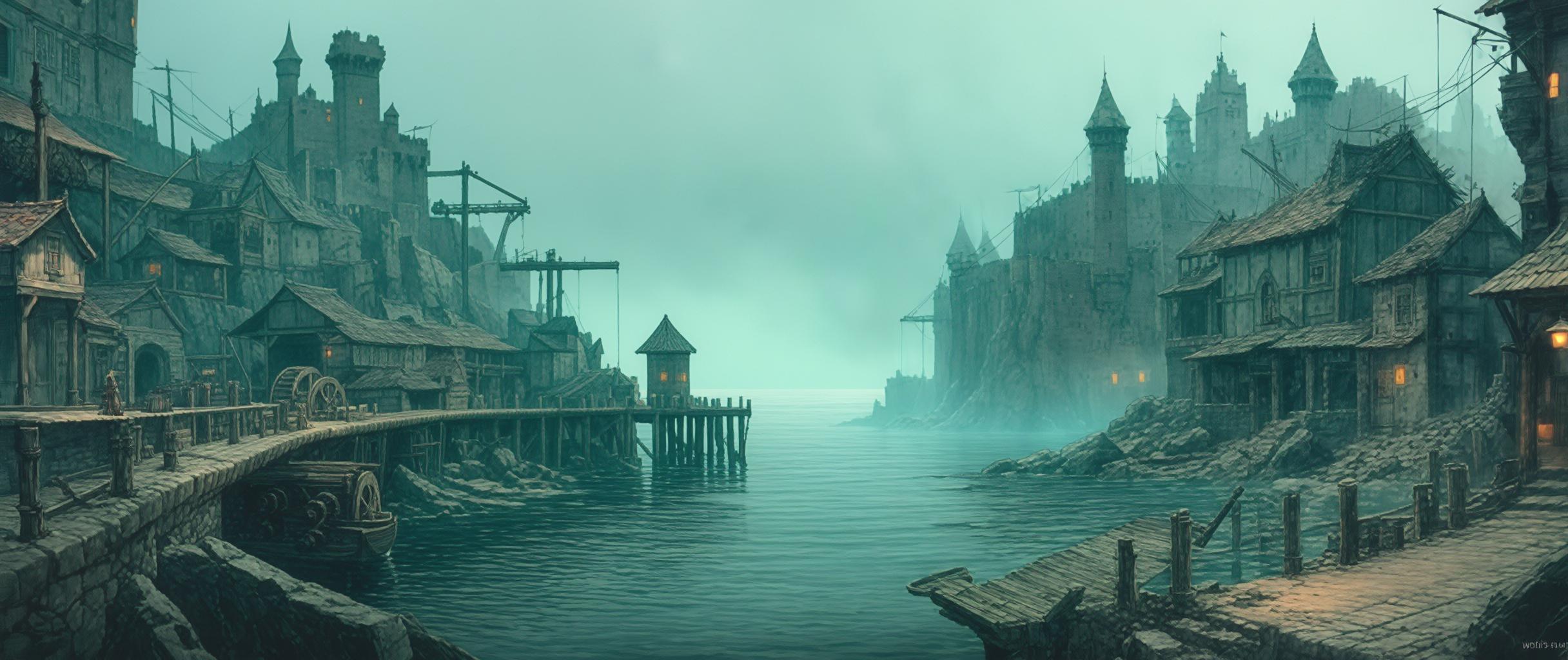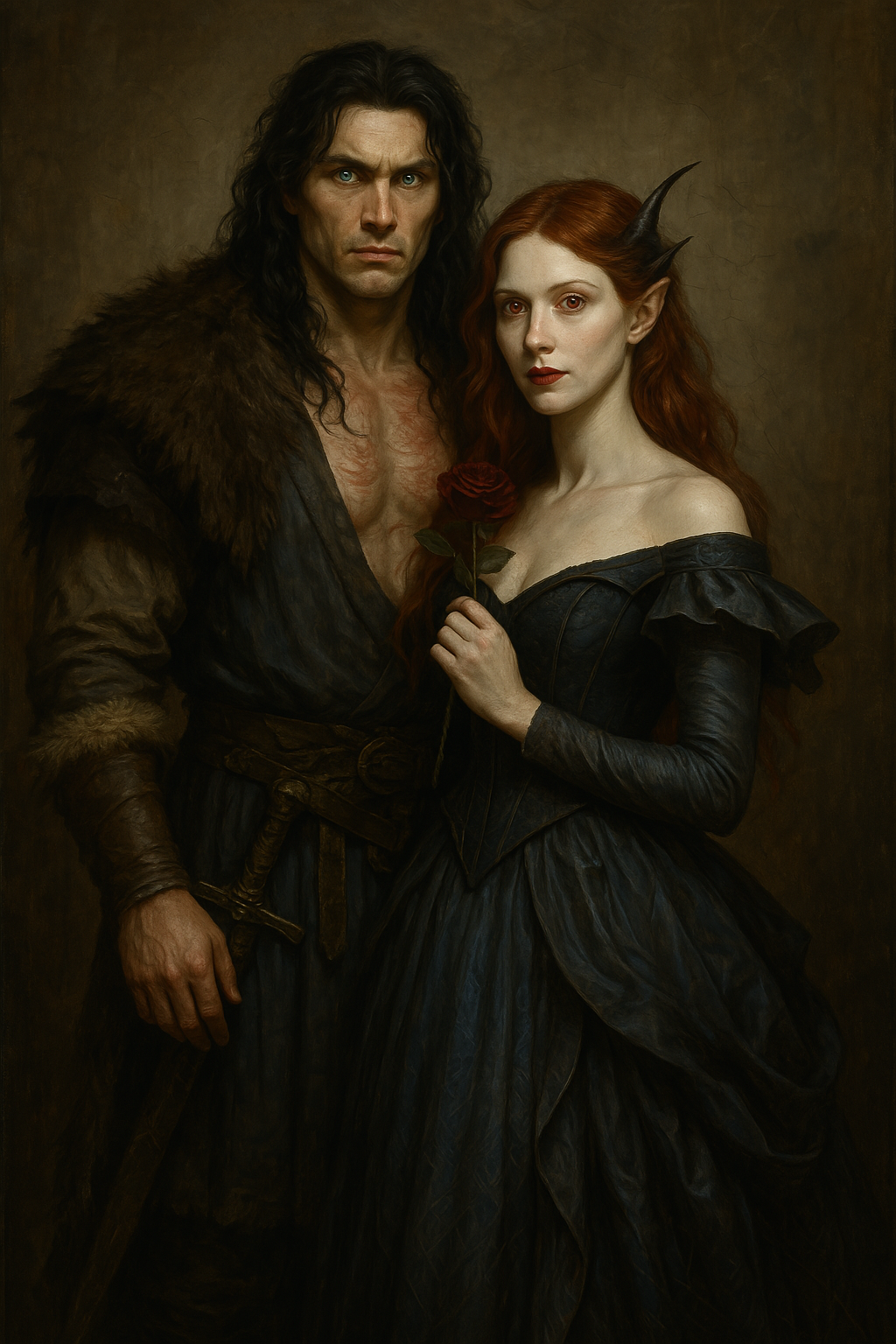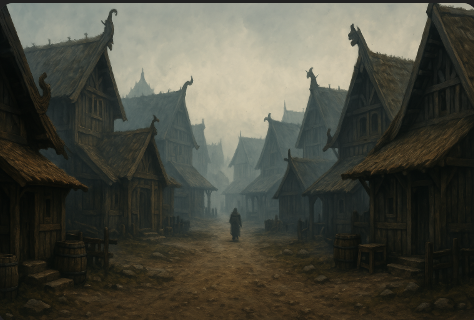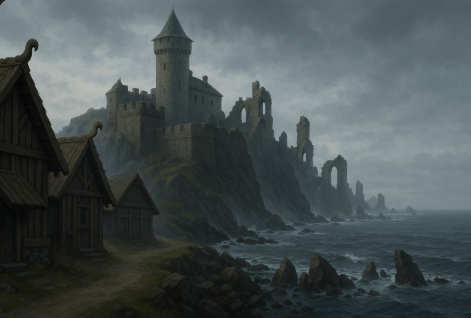Virifell
Virifell is one of the oldest cities on the continent, founded in the year 2952. Originally established as a coastal fortress town with strong Nordic influences, its cultural and architectural roots have endured the test of time. The city is known for its bustling port, shadowy politics, and eerie phenomena tied to its history. While much has changed since its founding, its identity as a weather-worn but resilient settlement remains deeply intact. At its core lies the tragedy of the original castle keep, which long ago slid from the cliffside into the sea—its ruins still visible during low tide, a monument to a forgotten disaster. Today, Virifell is ruled by Brytha "Grangerford" Varngrim. A fog creeps through its alleyways, and its denizens whisper of ghostly figures and rat swarms, while goblins scurry through the streets by night in a strange arrangement that serves both pest control and political theater.
Demographics
Virifell's population is diverse but distinctly divided by class and race. The majority are humans of northern descent, whose families have lived in the region since the original settlement. There are also sizable minorities of dwarves, goblins, and sea elves. The goblins, once outcasts, have found a unique place in the city’s social order, forming rat-catching guilds and mercantile roles. Wealthy merchants and clergy hold the most influence and live in elevated, reinforced districts, while the lower classes crowd the waterfront and the original settlement around the ruined keep. Despite its coastal wealth, much of the population lives in poverty, and the tension between classes is quietly growing.
Government
While the city appears to be a theocratic monarchy under Brytha Grangerford, true power lies in the influence of her "brother", Riament Grangerford, who manipulates city affairs from the Holy City. Brytha acts as his mouthpiece, rarely seen in public, and relies on Thames, her assistant, to enforce her decrees. After a recent “accident” incapacitated Thames, Brytha has taken direct control. The city now operates under a strict curfew, enforced by guards bearing enchanted holy symbols that grant night vision and allow Brytha subtle influence over their minds. Taxation is heavy, especially on trade goods, and a portion of all profits is sent to the Holy City.
When word spread that Riament Grangerford had lost control of the capital—the once-sacred Holy City that bore their "new" family name—Brytha vanished. She withdrew into the depths of the keep, seen only when necessity demanded it, and even then, only fleetingly. Among the people, rumors bloomed like mold in the fog: some said she feared for her life, others that her power had crumbled with her brother’s fall.
It was years later that Bertrom returned—weathered from his long absence, but bearing the weight of purpose. He stepped into the vacuum of power with quiet command, rallying the spirits of the people and setting forth a plan to lift Virifell from poverty and back into prosperity. His presence was a balm, a steadying force amidst the decay.
To this day, Brytha lingers more as a shadow than a sovereign. She moves behind curtains, speaks through others, and watches from the darkness. The townsfolk know she is still there—pulling strings, whispering orders—but few dare say she truly rules anymore.
Defences
The outer city is protected by a wooden palisade reinforced with iron and spiked barricades. The inner city, where the keep is located, is surrounded by a tall stone wall with guard towers—many of which are newer than the rest of the structure. Ballistae and oil cauldrons defend the walls, and patrols are constant. The sea-facing side of the city is vulnerable due to the cliff erosion and lost castle segment, though ships and coastal lookouts provide a degree of early warning.
Industry & Trade
Fishing, shipbuilding, and salt curing are the lifeblood of Virifell. It also acts as a middle point for inland trade, receiving goods and passing them to other inland cities, primarily Khatharbund. Slave trade, while officially banned, still occurs at night via the docks. Imports include cloth, spices, and metals; exports include fish, sea goods, lumber, and occasionally slaves or indentured servants. Smuggling and shadow trade also fuel a significant portion of the city’s economy.
Infrastructure
Virifell has aged like an ancient creature—proud but groaning beneath its own weight. Dirt streets, stone piers, and deteriorating bridges connect its districts. The city still maintains functioning aqueducts and water pumps, though many are in disrepair. Small waterwheels and hand-cranked lifts operate in the cliffside regions, while simple wooden cranes load and unload goods at the docks. A basic sewer system exists beneath the original settlement, though it is overrun with rats, fog, and the occasional ghostly presence. Lanterns using phosphorescent sea-moss provide light at night, though fog often smothers them.
Assets
Virifell is rich in seaworthy vessels, dark wood harvested from nearby coastal forests and preserved fish and sea-salt. Its blacksmiths are mediocre, but its shipwrights and carpenters are famous for crafting sturdy longships and trade galleons. Magical assets are limited, hoarded by the keep and clergy. Additionally, the goblin-run rat catchers possess a crude but effective network of tunnels, tools, and trade secrets.
Guilds and Factions
Key factions include the Night Guard, now under Brytha's full command; the Goblin Ratcatchers’ Consortium; and the Merchant’s Guild, which attempts to walk the line between serving the regime and securing its own wealth. The few remaining nobles serve mostly symbolic roles, their lineages tied to Brytha and Bertrom’s ancestry.
Points of interest
The Sunken Keep is the most infamous landmark, its remnants visible in the water like the ribs of a drowned beast.
Architecture
Virifell’s architecture is inspired by old Viking settlements—longhouses, steep gabled roofs, and timber-framed buildings dominate the skyline. Wood is dark-stained and often tarred against sea winds. Roofs are thatched or tiled with dark slate, and intricate wooden carvings of serpents, gods, and sea creatures adorn beams and doorframes. While some stone construction exists, especially in wealthier districts, wood remains the city's lifeblood.
Geography
Virifell hugs a jagged cliffside along the continent’s southern coast. Its beaches are rocky, and the cliffs fall sharply into the sea. The nearby forests provide timber, while the ocean yields fish and salt. Inland roads connect to trade routes, but storms and fog make sea travel more reliable. The Sunken Keep juts out into the water like a warning finger, and at dawn, its ruins catch the light in a ghostly shimmer.
Climate
The climate is cool and damp year-round. Rain is frequent, with heavy storms in the spring and fall. Winters are somewhat mild; however, at times there are sea winds that bite through even the thickest cloak. Summers are humid, often shrouded in fog. The city rarely sees sunshine for more than a few days at a time, lending it a perpetually overcast mood.
Natural Resources
The coastal waters provide abundant fish and salt, and the forests to the north and west yield timber. Limited farmland exists inland, but most food is imported or traded for. The city has modest clay deposits used for pottery and bricks. No known metals or precious stones exist nearby, forcing reliance on imports for weaponry and coinage.
“They call us cursed. They see the fog and the ruins and the rats and whisper that we are a city of ghosts. But they forget what it means to be born of salt and stone. We do not break—we endure. We outlast the tides, we rebuild from the wreckage, and we carry our dead not in sorrow, but in strength. Virifell stands not because the gods will it, nor because kings demand it, but because we will it. So let them fear our fog and curse our name. We will be here still when their voices fade to dust.”







Comments